
PETER ESTERHAZY
277
We have no satisfactory answers to these questions; indeed, it was the
attendant resignation hand in hand with the excitement over the new op–
portunities that made us capable not only of pushing against, but of
crashing right through the former barriers, and this is what finally ended
the whole thing.
The new problem
No one knows for certain what it is that has begun . Generally, no
one knows anything, East or West. Europe was a communal shrug of the
shoulder, this is our new unity. Otherwise, East and West continue sepa–
rate.
It
became apparent soon enough that such unification does not
happen overnight. Furthermore, not only is there an East and a West
(though metaphorically it is more like North and South), there is also
something that is
central,
this neither here nor there (actually, more like
there, but with a hopeful eye to
here,
or vice versa), even if the definitions
are different. Possibly there are no definitions, even, only feeling and
looking. I feel Eastern; he looks like Karl Marx Stadt. (Or whatever it's
called now.)
But easy. Take it easy.
An inventory
if
problems
The problem of money. Until recently, we were not familiar with
the power and sway of the almighty forint, and now we are experiencing
a rude awakening. We have not yet elaborated our small spheres and
structures of defense. The old forms of official state support for the arts
are gone. The new are just being formulated . Generally, the old structures
are collapsing, while the new are nowhere in sight. Easy come, easy go.
The problem of publishing. Instead of the discrete euphoria of liberty,
we now often have the liberty of the worthless. The altered book shops.
The altered books. (Liberated Europe, around these parts, is not familiar
with the hard-bound book, only the paperback. As far as our children are
concerned, a book is something that falls apart when you open it.)
The problem of print runs. The loss of prestige, as I see it, is not the
problem. Having lost its political weight, literature is back in its place .
Evidently, some writers find it difficult to adjust. But that's not the prob–
lem. To have a print run of five thousand instead of thirty thousand is a
problem only for the sociology of reading, and a financial problem, too .
But three hundred instead of three thousand, now that is entirely differ–
ent.
It
provokes certain questions: What is art for? What is its place?
(Where should we force room for it through some narrow crack between
McDonald's and Sarajevo?) For whom are we waiting? These were never
friendly questions, but the shadow of dictatorship, which was a question


